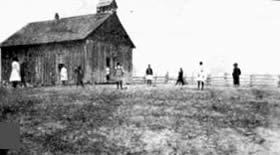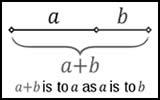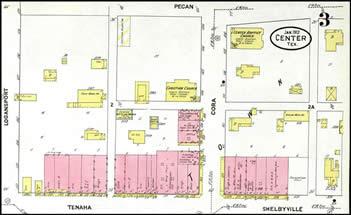The Heritage Corner
May 11, 2015 - During the years of the Republic, Texas considered education important. Even as early as 1840, four leagues of public lands were set aside in each county to support public education. In 1845 a permanent school fund for the State of Texas was instituted. In 1876, after the Civil War and Reconstruction, a new constitution addressed the issue of school funding. Such concern for public school funding continued into the 20th century.
 Implementation of free public education, however, moved much more slowly, with state guidelines for independent school districts beginning to surface in 1885. So it was that free public education in Texas was not broadly available until very late in the 19th century. This void was especially felt in the rural areas of Shelby County, while records show that Center had a school building in 1880. (Shelby County Deed Records, vol. 56, p. 436)
Implementation of free public education, however, moved much more slowly, with state guidelines for independent school districts beginning to surface in 1885. So it was that free public education in Texas was not broadly available until very late in the 19th century. This void was especially felt in the rural areas of Shelby County, while records show that Center had a school building in 1880. (Shelby County Deed Records, vol. 56, p. 436)
Such a situation in the late 19th and early 20th century caused some Shelby County citizens to react in at least two ways, repeated countless times and partially overcoming the hardship. First, enterprising individuals began setting up very small and private schools across the county; and second, some families in rural Shelby County sent their children to board with other families in Center whenever no school was in their community. Of course, the alternatives were home schooling or no school at all, and many families had no means to do otherwise.
These positive responses to a lack of free public education started at least by 1881 and continued into the early 20th century. Their results not only reflected the importance of enterprising individuals who preserved educational instruction in a private setting but also implied that "rooming houses" were indirectly important to education. Boarding accommodations provided a functional service to rural families and sometimes generated a modest supplementary income.
While this concern for education was wide-spread in the county, small 19th century rural communities first had as their foundation a church, cemetery, general store, and even a post office before schools were established. Still, there is a clear record of private schools becoming a part of many Shelby County communities by 1881, and it is reasonable to assume there were some before that time.
As confirmation of this, there are several facts reported by Mildred Cariker Pinkston in People, Places, Happenings: Shelby County, Texas that are summarized and presented below.
- Early "public" schools charged a modest tuition. Center High School did so in the fall of 1881.
- The label "public free school" was not found until September of 1890.
- In that same year (1890), other larger communities such as Tenaha began to introduce public education as independent school districts began to emerge.
- There were numerous private schools and teachers in the county before 1890. Examples: Professor J.T. Mann, Miss Justine McCary, Swanzy's School (probably at Halbert), Joe Paxton, Prof. W.P. Hayes, L.S. Austin, J.D. (John) McCallum,
- Miss Laura Oliver, J. J. Rushing, Jimmy King, Frank Whiteside, J.O. Cooper, Miss Laura Oliver, Miss Mary Ross, Miss Alice Wheeler, Miss Maggie Windham, Mrs. M.T. Johnson, Mary McCary, Miss Carrie Armstrong
- Examples of small communities that were served by at least one private school were: Walnut Grove, Patroon (at least two), Halbert, New Hope, Mt. Pleasant, Short, Ramah, White Rock, Sand Hill, Huana, Huber, Good Hope, Cedar Yard, Olive, Eagle Mills
- Starting with the same school year when free public education began to emerge (1890), many of these previously-successful private schools began closing.
More details of 19th-century private education in Shelby County will be available for reading in the summer issue of We the People of Shelby County (www.shelbycountytx.com).
April 27, 2015 - The Christian Cross as a Symbol of Perfection
Since my days of research regarding aesthetics and its relationship to math, I have been fascinated with a numerical arrangement called the Fibonacci Series. While this mathematical phenomenon is simpler to generate than to understand, its essence as a reflection of perfection shapes aesthetical as well as mathematical principles and is found also in the physical sciences. It has only been recently, however, that I have recognized that same essence embodied in the shape of the Christian cross.
The Fibonacci numbers are in ascending order, starting with 0 and 1, and continue to infinity; and each ordered number in the Fibonacci Series is a sum of the previous two numbers in the series. So the Fibonacci Series is 0, 1, 1, 2, 3, 5, 8, 13, 21, 34, 55, 89……That may seem to be more of a mind exercise than a special phenomenon until we realize this: the ratio being restated with any pair of adjacent numbers approaches the better-known Golden Mean (phi): 1.61803. The formula which expresses this logic is 
Some would define perfection in simple geometric design, including architecture, in these terms. Given b as 1, then a would be 1.61803. The implied ratio, therefore, is 1 to 1.6 (rounded for simplicity’s sake).
The grey rectangle of the three below uses the ratio 1 to 1.6 for the sides; the other two do not. Which one do you think is more aesthetically appealing (beautiful)?



Whether by plan—as with architecture, from the Parthenon's façade to contemporary buildings; or by artistic choice—works by Leonardo da Vinci (Last Supper, Mona Lisa, Self Portrait); or made by God—a multitude of plant characteristics, the shapes of the human face and ears, the spiral nature of solar systems, the overtone series in music; or even in common every-day design—shapes of postcards, posters, wide-screen televisions, photographs, light switch plates, and cars—application of the Golden Mean often moves the design toward perfection.
With such complex mathematical and aesthetic principles as background information, it may seem much easier, and a rather natural fit, to place the Christian cross within a rectangle suggested by the Golden Mean. It is here that the earlier-described perfection in mathematics and aesthetics may enhance the spiritual perfection of the Christian cross.

April 9, 2015 - It may be trivia but it is a little-known fact: “Thirty-Two Flags over Texas” is a bit more complete than saying “Six Flags over Texas.” (Don’t forget that the transition from thirteen to fifty states over time required twenty-six versions—a new flag every time a star was added.)
And, as one would expect, Texas has more counties than any other state (254); and of those counties, four of them (Harrison, Parmer, Rains, & Roberts) are named after Shelby County residents. No other county can boast of this fact.
Did you also know that Tanaha (not Nashville, as popular sources say) was the first name for the village of Shelbyville?
We recently dealt with a change from Standard Time to Daylight Savings Time; it reminded me that our time zones in the United States are separated by one hour. However, rather far to our east and north, Newfoundland is separated by ½ hour from its time-zone neighbors…..Interesting…..
What about this? As an original county in the State of Texas, Shelby County first included what are now the counties of Panola, Harrison, and a portion of Rusk.
Without doubt, the little-known fact I most enjoy exposing is this: there are specific dates in the 18th century calendar Which Do Not Exist. They are Sept. 3rd through the 13th, 1752. Do you believe this is fact? Check it out with a multi-year calendar that reaches back to the 18th century (such as http://calendarhome.com). One of my archived articles in the Summer 2013 issue of We the People of Shelby County explains this phenomenon.
Some might suggest that most or all of these previous statements have no relevance in today’s world, so let us examine a little-known fact that readers who follow day-to-day politics may find informative or, at least, amusing.
Yes, it’s true; we had a political entity in the United States with a bit of clout, helping to shape our destiny, called the Locofoco Party. The Locofocos influenced President Martin Van Buren, a democrat, so much that the opposing party (the Whigs) labeled the entire Democrat Party the Locofocos in the early 1840's.
The Locofoco Party was a segment of the Democrat Party for a rather brief period during the first half of the 19th century. While its time span was more limited and did not have as much strength, in some ways it might be considered as the democrat’s Tea Party of an earlier time. Even in those days of the first half of the 19th century, “factions created a grid-lock situation in which many Americans, religiously devoted to the Republic, found themselves frustrated with the landscape of politics.” (thelocofocolog.wordpress.com)
In its six-year life, the Locofoco Party grew in number, meeting privately at times to try to preserve their principles. Some opponents thought they were anti-economic growth and anti-industrialization, but they stood opposed to taxes, hierarchies, governors, and too much government control. (Jacob Harris Patton, Political Parties in the United States: Their History and Influence. New York: 1896)
Their label sounds stranger than their principles. Depending on what side of the aisle you sit, it might be said that we could use a bit of Locofoco thinking today.
March 23, 2015 - The spring issue of We the People of Shelby County will be available for reading at www.shelbycountytx.com on April 1. In this second in a series about storefronts on our historic square, their history dates from before the historic courthouse was built and continues into the 21st century. Many citizens of Center have been helpful by providing oral as well as written history, and that support continues even as the summer issue begins to take shape.
 Yes, those few stores in the last quarter of the 19th century were very different than those today. Starting as early as 1867, with a few stores at the most important crossroads in the area (now the intersection of Tenaha and Nacogdoches Streets—the NW corner of our square), the square format soon began to emerge with the construction of the new courthouse in 1885. Soon, Shelbyville Street was functioning as Center’s main street, with businesses and homes stretching from the square to the new train station in east Center by 1902. (See the accompanying 1912 diagram of the north side of the square, two blocks deep.)
Yes, those few stores in the last quarter of the 19th century were very different than those today. Starting as early as 1867, with a few stores at the most important crossroads in the area (now the intersection of Tenaha and Nacogdoches Streets—the NW corner of our square), the square format soon began to emerge with the construction of the new courthouse in 1885. Soon, Shelbyville Street was functioning as Center’s main street, with businesses and homes stretching from the square to the new train station in east Center by 1902. (See the accompanying 1912 diagram of the north side of the square, two blocks deep.)
In contrast to this earlier time, stores and services located on the square in the 1950's were more similar to what we see today, although that comparison is a relative one. For example, of the fourteen storefronts on the north side of the square in 1950, only one (Farmer's State Bank) remains today. We had several barbers to choose from, a couple of department stores and hardware stores, several clothing stores, two banks, and a variety of specialty shops, small cafes, cleaners and other services.
We bought our cars on or near the square and visited the corner post office every day. We still had grocery stores on the square and others very near the square, although outlets for food and farm supplies were rapidly moving to the outlying areas. Yes, it could be said that, in the 50's, we could still make a trip to the square for one-stop shopping, just as our grandfathers did in much earlier times.
Many of the stores have a rich history to report, and some of them had owners and employees whose descendants we now know as productive citizens of Center. The O.H. Polley Mercantile Dry Goods Store on the north side of the square, for example, existed from 1920 to 1969; its long life necessitated its three founders (O.H. Polley (Sr), H.H. Jones (Sr), and M.B. Simon) to employ so many individuals that they were as difficult to count as to name. Such effort has been made however, and readers may want to add to the list. You may do so by email: dpswanzy@shelbycountytx.com
(The writer publishes “We the People of Shelby County,” a free online magazine about local history. He may be contacted at dswanzy@shelbycountytx.com.)
 January 13, 2015 - The Summer 2013 issue of We the People of Shelby County featured the history of Shelby Savings Bank, and while preparing that issue, I got to know Gail Cuculic quite well. Now, with his funeral set for Jan. 14 and with little time to write a formal tribute, I can at least provide two sets of quotes about Gail from that issue. Perhaps his contributions to Center, his warm and gentle personality, and his noble character are at least partially reflected in these quotes.
January 13, 2015 - The Summer 2013 issue of We the People of Shelby County featured the history of Shelby Savings Bank, and while preparing that issue, I got to know Gail Cuculic quite well. Now, with his funeral set for Jan. 14 and with little time to write a formal tribute, I can at least provide two sets of quotes about Gail from that issue. Perhaps his contributions to Center, his warm and gentle personality, and his noble character are at least partially reflected in these quotes.
The first set of quotes is from a major section of that issue, A Concise History of Shelby Savings Bank. (Chapter 4-Chapter 5)
"At the beginning of June 1984, Gail Cuculic joined Shelby County Savings Association as a vice president, coming back home from Houston due to the encouragement of James Campbell and Fred Wulf. Gail had earlier left his position at Sabine Valley and was working in Houston. This return to Center by Gail was rather important to SCSA, since Gail would soon become President the following year… He would serve as Bank President from 1985 to 1992, a time span longer than he expected since he understood his appointment was to be for an interim period…. He retired from the Shelby County Savings Association on Feb 28. 1994….
Gail was a CPA, a businessman, and a man with a good knowledge of banking regulations. Such qualifications were important to the rapidly growing bank, and he served with distinction....
At an open house in honor of Cuculic's retirement in 1994, James Campbell spoke about how important Cuculic's leadership was for over five years. ‘The Bank has been and continues to be fortunate to have someone with Gail's financial, accounting, and management expertise associated with the institution.’"
To read these statements about Gail Cuculic in context, please feel free to visit the magazines’ archives at www.uniqware.com/magazine6/level1htm/ssbhistory.htm
The second set of quotes is provided to give everyone a chance to take a peek at his autobiography, My Achin' Back (by Gail Cuculic as told to Janie Cuculic). I was given an autographed copy by Gail, and it introduced me to a man whose life was full of rich experiences that led to his leadership at Shelby Savings Bank.
"Gail Edward Cuculic was born in 1926. His father had immigrated from Croatia and Czechoslovakia in the early 1900's. His memories of the Depression years were of share cropping and living in cramped quarters with no indoor plumbing or electricity. He began his first paying job at a service station at the age of fourteen and worked there through high school….
Then it was on to Stephen F. Austin in June of 1943, but he enlisted in the Navy in 1944. The Navy life took him to San Diego, Memphis, New Orleans, Ruston, New York, Okinawa, and Korea.
Back in Center after his stint in the Navy, he became a member of the First United Methodist Church and a charter member of the Center Country Club. Gail worked as a CPA for several companies prior to his association with Shelby Savings Bank.”
Terri Lacher reviewed Gail’s book for the Summer 2013 issue of We the People of Shelby County, which you may read in its entirety at www.uniqware.com/magazine6/level2htm/achinBack.htm

December 29, 2014 - In contrast to a much earlier time as reflected in the accompanying north-side detail from the popular 1923 Loving photo, I remember Center’s Historic Downtown Square in the 50's as more similar to what we see today. Nevertheless, there are significant differences that continued to occur after 1950. For example, of the fourteen storefront operations on the north side of the square in 1950, only one (Farmer's State Bank) remains today.
In the 1950’s on the square we had several barbershops to choose from, a couple of department stores and hardware stores, several clothing stores, two banks, and a variety of specialty shops, small cafes, cleaners and other services. We bought our cars on or near the square and visited the square’s corner post office every day. We still had a grocery store on the square and others very near, although outlets for food and farm supplies were rapidly moving to the outlying areas. It could be said that, in the 50's, we could still make a trip to the square for one-stop shopping. For better or for worse, it seems rather sad to me that the location for one-stop shopping has shifted to the loop, primarily because of what I call the “Walmart syndrome.”
To pursue such square detail even further, an analysis of the evolution of its storefronts from the late 19th century until 1950 will be featured in the January Issue of We the People of Shelby County (www.shelbycountytx.com). After covering the west side in January, the other sides will be addressed in succeeding issues.
To move past this first issue, however, I need the help of those who lived here during much of the last half of the 20th century. What do you remember or what photographs of the square’s storefronts might you have? I’ve noticed that photos taken during downtown parades are helpful, but I still have not filled in “all the blanks.” You might be surprised that my best work on “square research” is probably storefront identification prior to 1950; you would think that, after 1950, it would be easier. It’s not, however, and maybe that is because there were numerous changes of building occupants in these last sixty-five years.
It would be extremely helpful to receive whatever comments or photograph copies you are willing to share at dpswanzy@shelbycountytx.com. Thanks in advance for your assistance and enjoy the January 2015 issue
 In contrast to a much earlier time as reflected in the accompanying north-side detail from the popular 1923 Loving photo, I remember Center’s Historic Downtown Square in the 50's as more similar to what we see today. Nevertheless, there are significant differences that continued to occur after 1950. For example, of the fourteen storefront operations on the north side of the square in 1950, only one (Farmer's State Bank) remains today.
In contrast to a much earlier time as reflected in the accompanying north-side detail from the popular 1923 Loving photo, I remember Center’s Historic Downtown Square in the 50's as more similar to what we see today. Nevertheless, there are significant differences that continued to occur after 1950. For example, of the fourteen storefront operations on the north side of the square in 1950, only one (Farmer's State Bank) remains today.
In the 1950’s on the square we had several barbershops to choose from, a couple of department stores and hardware stores, several clothing stores, two banks, and a variety of specialty shops, small cafes, cleaners and other services. We bought our cars on or near the square and visited the square’s corner post office every day. We still had a grocery store on the square and others very near, although outlets for food and farm supplies were rapidly moving to the outlying areas. It could be said that, in the 50's, we could still make a trip to the square for one-stop shopping. For better or for worse, it seems rather sad to me that the location for one-stop shopping has shifted to the loop, primarily because of what I call the “Walmart syndrome.”
To pursue such square detail even further, an analysis of the evolution of its storefronts from the late 19th century until 1950 will be featured in the January Issue of We the People of Shelby County (www.shelbycountytx.com). After covering the west side in January, the other sides will be addressed in succeeding issues.
To move past this first issue, however, I need the help of those who lived here during much of the last half of the 20th century. What do you remember or what photographs of the square’s storefronts might you have? I’ve noticed that photos taken during downtown parades are helpful, but I still have not filled in “all the blanks.” You might be surprised that my best work on “square research” is probably storefront identification prior to 1950; you would think that, after 1950, it would be easier. It’s not, however, and maybe that is because there were numerous changes of building occupants in these last sixty-five years.
It would be extremely helpful to receive whatever comments or photograph copies you are willing to share at dpswanzy@shelbycountytx.com. Thanks in advance for your assistance and enjoy the January 2015 issue.
The online magazine, We the People of Shelby County, features local history about our communities and our earlier citizens who lived there. But it also includes informative articles about the broader history of Texas. This is increasingly important to the magazine because “sister publications” of We the People of other Texas counties are in various stages of development, with the San Augustine County edition already published and a Gregg County edition scheduled to begin in January 2015.
 One example of an article on broader Texas history was just submitted by Marlene Childs, who grew up in Center (remember the Childs’ Store?) but now lives in Lubbock. Marlene’s article, Davy Crockett’s Women, is a “spotlight” feature in the next (October-December) issue of the magazine. She is a talented writer whose association we are fortunate to have.
One example of an article on broader Texas history was just submitted by Marlene Childs, who grew up in Center (remember the Childs’ Store?) but now lives in Lubbock. Marlene’s article, Davy Crockett’s Women, is a “spotlight” feature in the next (October-December) issue of the magazine. She is a talented writer whose association we are fortunate to have.
There has been a lot written about Davy Crockett that I have enjoyed, but this article provides a fresh insight about the life and times of Davy. As Marlene points out, there is at least “one other facet of Crockett besides hunter, fighter, politician, and teller of tall tales.”
Of course, the first woman in his life was his mother, Rebecca Hawkins Crockett, whose first known American ancestor was an English immigrant, arriving in Virginia in 1658. After marriage to Davy’s father, John, they moved to Greene County, Tennessee. Davy’s parents ran a farm, a gristmill, and a tavern.
Davy had three sisters, so it is not surprising that they were the next females in his life. While little is known about Davy’s relationship with his sisters, he named the first of his own daughters, Margaret, after his oldest sister.
 Davy’s first woman with whom he fell in love was Amy Summer, a Quaker. He was soon heartbroken because Amy’s parents insisted on a Quaker marriage. Coming along soon was his next love, Margaret Elder, who was from a family the Crockett family had known for some time. But that second love relationship collapsed as well. Marlene Childs explains that, among several reasons, “he probably celebrated with too much revelry.”
Davy’s first woman with whom he fell in love was Amy Summer, a Quaker. He was soon heartbroken because Amy’s parents insisted on a Quaker marriage. Coming along soon was his next love, Margaret Elder, who was from a family the Crockett family had known for some time. But that second love relationship collapsed as well. Marlene Childs explains that, among several reasons, “he probably celebrated with too much revelry.”
It was at a social event that included music and dancing that Davy met his future wife—Polly Finley. Davy and Polly married in 1806 in Jefferson County, Tennessee. They had three children: John Wesley, born in 1807; William, born in 1809; and Margaret, born in 1812.
Marlene Childs states that Davy was “genuinely devoted to Polly, and Davy described her as both a tender and loving wife and a good and affectionate mother. Their time of bliss together, however, was brief. Only in her mid-twenties, the love of his life died in 1815 in Franklin County, Tennessee.”
As we all know, the story of Davy Crockett does not end with the death of his wife; nor is it the end of the story of his women. Because of the detail she provides, Marlene has chosen to divide the story into two parts. Part Two will be published in the January 2015 issue of We the People of Shelby County (www.shelbycountytx.com).









